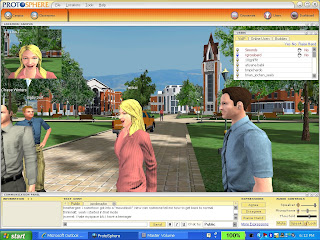 Erika, our guide for ProtoSphere, talks to the group.
Erika, our guide for ProtoSphere, talks to the group.This week's class proved to be exciting as we got a guided tour of ProtoSphere from Erika of ProtonMedia, used the VOIP in Second Life and had a group challenge where teams of students (dressed as fire fighters) cleaned up make believe chemical spills in teams of 4 or 5. The idea behind that exercises was to help them learn how teamwork principles can be applied in a 3D world to help with team building, cooperation and coordination.
The ProtoSphere demonstration was great, we got to learn how to use gestures in-world and we got to go play a wheel of fortune game, see a large classroom and experience the social networking aspects of ProtoSphere and how you can click on an avatar and see a person's real-life profile.Our host also explained the different types of companies using the product and gave information on how they partner with organizations to set up and deploy the ProtoSphere application. You can check out ProtoSphere for yourself by viewing a demo at ProtonMedia's web site.
Later in the evening, we discussed designing instruction in a 3D world...Analysis of the learning objectives, Design of the learning events, Development of the in-world scene, Implementation of the technology and finally Evaluation of the educational experience from the in-world learning. Basically, we applied the ADDIE model of instructional design to building a 3D synchronous learning experience. The model is applicable just the specific details are applied differently and the design of the environment in which the learning occurs is critical to success.
 The whole class standing around the main campus in Protoshere.
The whole class standing around the main campus in Protoshere.You can see the presentation discussing the ADDIE model for 3D worlds at Designing 3D Learning Events and peek into the class and some of the struggles we still have with the technology. I keep thinking of how similar the initial use of 3D worlds are to the early days of e-learning...first great hype and then great disappointment when the e-learning didn't live up to the hype and then a more realistic and positive use of the technology.
I think we are starting to see the wave of hype for 3D worlds starting to crash (see article How Madison Avenue Is Wasting Millions on a Deserted Second Life) and then, in the next couple of years, we will see more realistic use...but first some technical issues need to be worked out.
__
Recommended Games and Gadgets
Recommended Books
Content Guide































